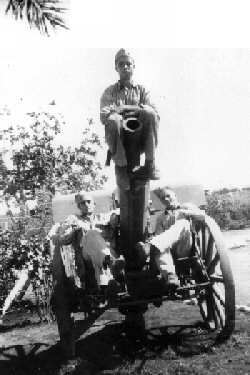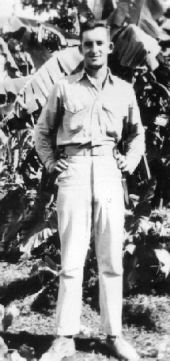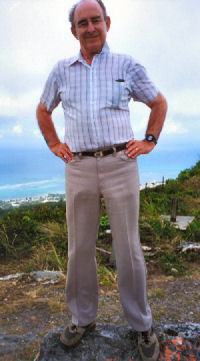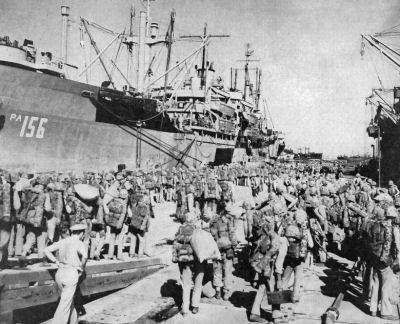
Figures 67, 68 and 69. Len and two buddies play around some captured Japanese cannons.
About this time I started having problems with my stomach. Marine Corps chow, although plentiful, was not the most tasty in the world, especially when cooked in field kitchens such as were used overseas. Even the thought of eating that greasy food got to where I was nauseous. Often, after eating I would simply lose it. I went to sick bay, but they didn't really do anything for me. I became resigned to this problem and hoped it would go away, but it was only to get worse as time went by.
One day we were practicing out at the rifle range when a Zero came into view. This was very unusual as we had not seen a Japanese plane for several months. It came diving down out of the sky followed by three U.S. planes; a Lightning P-38, an F6F Hellcat, and a Corsair. It immediately became obvious that this was more of a battle between the branches of service than it was a fight between nations. The Lightning P-38 was flown only by the Army. The F6F Hellcat was a carrier based Navy plane, while the Corsair was flown only by the Marine Corps. Most likely none of the pilots had seen combat before and this was their first opportunity. The poor Zero did not have a chance.
It looked at first like the Army pilot was going to win as his plane was the fastest and he was in front. Unfortunately, he was too fast. He shot right past the Zero and had to pull up out of his dive to avoid crashing. The Hellcat and Corsair were both on the tail of the Zero and firing their guns. We couldn't tell who got him, but the Zero crashed right at the end of our range. I'm sure both pilots claimed victory, and no doubt each was given credit for a half kill.
Some of the elements of the Fourth Marine Division stopped in Tanapag Harbor on the way to another campaign. We overheard the general commanding the Division addressing his men. He informed them that where they were going it would be rough, but they should consider themselves lucky as he also knew where those fellows were going, pointing at us, and stating that our destination would be rougher.


Figures 70 and 71. Fifty years separate the two photographs of Len taken on Mt. Tapotchau, Saipan.
A few days later the Fourth landed at Iwo Jima, which turned out to be the bloodiest battle the Marine Corps had fought during the entire history of the Corps. That didn't sound like good news to us.

Figure 72. Second Division Marines boarding attack transports in Tanapag Harbor, bound for Okinawa.
Marine Corps photo from Follow Me by Richard Johnston (1948).
By the first of March 1945, we were packing up ready to go on the offensive again. On March 25th, we were trucked to Tanapag Harbor and I went aboard the USS Newberry. The USS Newberry was a Haskell Class Attack Transport (APA158) with a compliment of 56 officers and 480 enlisted personnel. After putting out to sea, we learned our destination would be Okinawa, Ryukyu Islands.